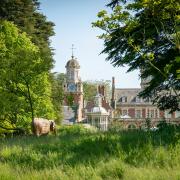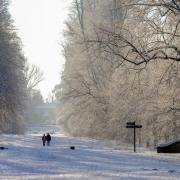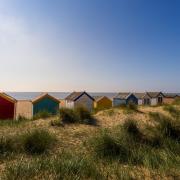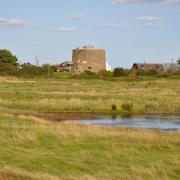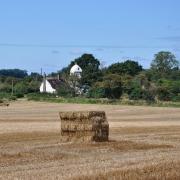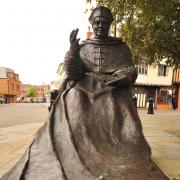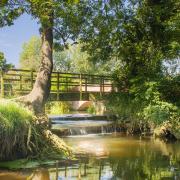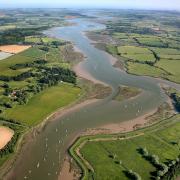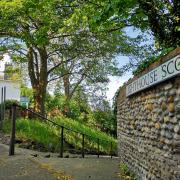Lindsay Want discovers a host of historic comings and goings, plus a right old Mid-Suffolk menagerie on a gentle country journey by the River ‘Rat’ near Stowmarket

Rattlesden. Now there’s an intriguing place in the back of Mid-Suffolk’s beyond. Set about exploring the village from somewhere near St Nicholas’ church and whether you take the High Road, and I take the Low Road, I’ll be at the whalebones afore ye. Well, possibly. The pubs en route are very tempting.
But whalebones there are, and a church door handle allegedly forged from an old local anchor - not bad for an enlarged conservation-area-of-a-cottage-cluster about 32 miles from the coast as the crow, buzzard or gull flies. It boasts a trickle of an eponymous river – River Rattlesden – which locals endearingly refer to as The Rat, perhaps in celebration of some resident rodent of repute.
Add to this, rumours of bloodhounds on a nearby airfield and all sorts of local monkey business and its irresistible half-timbered houses and thatched cottages suddenly seem just a small part of the attraction. Oh, how history leaves us grappling with all sorts of conundrums, but fortunately, there’s nothing like a good walk to see how the land really lies and come up with the connections.

There’s sure to be a spring in your step as you set out on your travels from Rattlesden recreation ground. Just part of Orwell Meadow, the site was acknowledged back in medieval times as the source of the River Ure, later re-named in parts as the rivers Gipping and Orwell.
So far away from the great Ipswich estuary, in such an idyllic inland enclave, it all seems a tad far-fetched, but then so too was the stone, shipped here all the way from Caen in Normandy, landed on long-gone rural Rattlesden quaysides and destined for the great abbey construction site at Bury. Local late-medieval monk and poet John de Lydgate wrote about it centuries later, so it must be true. And to think that some of the timbers in the thatched cottages here along Bird’s Green surely date from his day.
Many a history book has Rattlesden mooring its origins firmly to the boats (‘Rates’) full of 9th century Danes (‘Doenas’) which reputedly nipped up-river, past would-be Stowmarket, to continue westwards against the flow, before their crews disembarked in the high valley-lands for a spot of wild camping.

Beyond Orwell Meadow, past the allotments full of roots of a different kind, ever-bare and silvery trees stretch out their branches above the sheep grazing plains of Brook Vale, ghostly reminders of an oft forgotten river bank, banished now to losing itself in its own meanders.
Across the channel, betrayed by tall reed mace and dotted by delicate pink willowherb, the footpaths of Back Road steer a parallel path, tracing the course of the river just as the bright sunflowers which fill the field margins turn their heads to follow the sun.
When the cornfields on the rise up to Clopton Green’s estate shoot, at Bird’s Wood, shimmer gold in the high sun of summer, and the buzzard stretches out its wings full-span to catch currents of the ethereal kind, this sleepy corner of Suffolk almost whisks you away on a whim to Provence.

Let the mind’s eye magic up a rocky gorge or two and a donkey called ‘Modestine’, and the green lanes may even carry you off to the land of Robert Louis Stevenson’s famous travels. Well, this too is ‘An Inland Voyage’ for sure.
A trip down Gipsy Lane
One path leads to another, until you happen upon Gipsy Lane – a special Suffolk spot where time is happy to park itself a while, just like the painted waggons of days gone by. As it makes a B-line for Buxhall Fen Street, it’s a wide, well-travelled trail, the greenest of green tracks, canopied by a leafy tarpaulin.

Here, the mere crackle of branches above, or wisp of mist weaving low between the trees of the alder carr, are enough to kindle nostalgic images of campfires and cooking pots, of children taming songbirds to feed from little fingers and mothers crafting pegs and primrose baskets from wood collected from the coppice.
“To live out of doors with a woman one loves is, of all lives, the most complete and free,” wrote Stevenson. Maybe such happy, itinerant folk - workers vital to farming Suffolk’s ever-turning wheels of preparation and harvest - were going about their business here when the local wainwright passed through in 1896.
Follow in his likely footsteps along green and ancient Church Lane. He too would have caught sight, across the fields en route to Shelland Green, of Great Finborough’s fanciful church spire. Mind you, ‘Phipson’s folly’ was still very new in those days and the little church at Shelland – one of just six in England dedicated to that notorious Scot with divine designs, King Charles the Martyr – was still in private hands. The wainwright’s path was a purposeful one.

The church’s new owner was keen to put a personal brand stamp on the place and commissioned him to paint its Georgian interior in the same bright colours as his waggons. Perhaps unsurprisingly, the garish colours survived subsequent redecoration in the still quite psychedelic 1970s. Pop in today though, and you’ll be relieved – or disappointed - to discover that 2010 decorators gently toned them down to more subtle and contemplative pastel shades.
It’s colourful stuff indeed, this little patch of Suffolk. Pick your way through Shelland’s dandelion and oxeye daisy-dotted green, pondering why the church font is topped with a pineapple, or the hymn repertoire of its rare barrel organ boasts a tribute to Sicilian mariners.
Past the thatched cottages, the great orangey-pink brick chimneys of Rockylls Hall are eye-catching. They date from the 17th century, so what of the medieval manor site, and its rare and highly renowned historic pigsties?

On the high ground beyond Bird’s Wood, Tudor Clopton Hall joins in the local game of disguise, hiding behind curves and columns, Georgian windows and symmetry, peeping out furtively between trees and over hedges. Look hard, though, as its partial medieval moat is still visible to the front of the hall.
What goes around, comes around. Back in Rattlesden, the cast iron village sign forges all the links between church, river, anchor and whalebones. But why no reference to wheelwright, Richard Kimball, who in 1634 led local Puritan pilgrims to a new life in Massachusetts Bay?
Or to those US citizens who returned centuries later to protect our coast and countryside, the 447th bomb group who operated out of Rattlesden airbase? It’s something to scratch your head about as you pass the monkey-puzzle tree or pay homage to the gibbon ‘gargoyle’ on St Nicholas’ church.
The walk
1) Start at Rattlesden recreation ground off Bird’s Green (Road). Head up the concrete path alongside the pavilion. At the allotment gates keep left, taking the grass path straight ahead to the first of three stiles. Stiles one and two lead into riverside meadows.
2) Stile three delivers you to the Stowmarket Road. Turn left, walking along the road for a few metres. It bridges the River ‘Rat’. At a left bend take the track (right) past candy-pink Brookvale Farmhouse (right). Continue straight ahead, ignoring a first footpath to the left.
3) At the T-junction/footpath crossroads turn right on to the track called ‘Back Road’. It will curve back round to Stowmarket Road, so be sure to look out for the left turn into the wooded path known as ‘Gipsy Lane’. Continue all the way to the road.
4) Cross the road heading a few metres to the right to find the path known as Church Lane (left - restricted byways sign between hedgerows). Wide and gently wooded, it leads uphill, before opening out to fields with views back to Great Finborough’s wacky spire. Continue ahead (field margin path). Shelland’s church comes into view.
5) The church of King Charles the Martyr is usually open, services and ceremonies permitting. Out of private ownership only since 1936, it’s packed with Georgian box pews. Don’t miss the triple decker pulpit, flock wallpaper, barrel organ and 11th century font. Outside on the little green, cross the lane and go left to take the unmade road (right).
6) Follow footpath signs around the green towards Rockylls Hall where the Burdolf family were lords of the manor in the late 1200s. Cross the driveway to the hall to another grassed area and re-join the lane. Turn right, down the side of the hall, then go left at the junction and continue for a short distance.
7) Turn right to join a tree-clad footpath just after a property (field to left, gardens to right). When you reach a field, turn left, following the footpath round the field, to turn right uphill towards Bird’s Wood. At the top of the hill, continue all the way along the woodland’s edge (left).
8) At the end of Bird’s Wood, go right across the top of the field to Great Wood. Turn left onto the gravel drive skirting the woodland, then left at the end of the wood. Next, follow the track right, then left, through open fields, turning left again at the next track junction near the agricultural buildings of Clopton Green Farm.
9) Ahead is Clopton Hall with its Georgian façade. Turn right before the hall, going through the hedge, over a wooden footbridge onto a footpath. Pass farm buildings, bear left to edge a field before heading right at the next corner, then left beside a dense hedge (right).
10) Towards Great Finborough’s spire, head left, then right onto a wide grassy path which points towards the road. Just before the road, turn left down the steep field margin path (parallel to road). Rattlesden will eventually appear, church spire first, out of the deep valley. Look out for a wooden bridge in the field corner for a path down to the road junction.
11) Turn right to view the village sign on a little green (right), then continue along High Street.
12) St Nicholas’ church has a fine interior including an angel roof, art nouveau lamps and memorial chapel for 447th Bomb Group. Go left out of the church through the gate by the half-timbered house, then right, up Church Path to re-join High Street. Turn left and follow the road downhill.
13) Look out for the whalebones (just past the school) straddling the river, wooden replicas of the originals, made in 2000. Finally turn left to take Lower Road back to meet Bird’s Green (Road) and the recreation ground.




